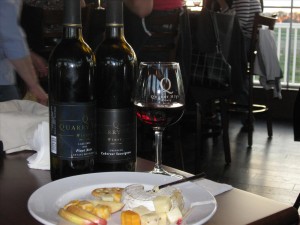Quality Wines Programs Expand in Midwest

As the Midwestern wine industry continues in its rapid growth and the production of high quality wines, it also continues to combat a long-held perception that the best U.S. wines come from California. Several Midwestern states, beginning in Ohio, developed, or are developing, quality wines programs that recognize state-grown wines and promote as an alternative to California.
Christy Eckstein, executive director of the Ohio Grape Industries Committee, believes the four-year old Ohio Quality Wine Program has been a factor in growing demand for Ohio wine. “Five years ago we had 85 wineries in Ohio; today there are 155,” she said. “The consumer opinion of Ohio wines has increased as a result of the Ohio Quality Wine Program and sales have grown at the same time.”
For the Ohio Quality Wine Program, wineries are encouraged to submit wines made with 90% or more Ohio grown grapes to a blind testing panel which judges the wine on chemical and sensory factors. “We judge all wines on same 20 point scale.” Eckstein said. Wines that meet the judges’ criteria are identified “Ohio Quality Wine” and receive a special “Ohio Quality Wine” seal as well as point of sale promotional materials
The program started slowly, Eckstein recalls . But as the number of Ohio wineries increased and word of the quality program spread, the number of submissions increased. Now, of Ohio’s 153 wineries, 30 are submitting anywhere from one to five bottles for judging. Originally, the program was open only to wines made from vinifera and hybrid grapes, but as of January 2012, the program will expand to include heritage varieties like Catawba and Niagara.

Quarry Hill Winery in Berlin Heights Ohio has been part of the Ohio Quality Wine Program since 2008.
As the Ohio quality wine program gains recognition for its success, other Midwestern states have developed or are in the process of rolling out their own programs.
Iowa began its quality wine program a year after Ohio – but modeled its program after the Canadian VQA (Vintners Quality Alliance) program which emphasizes terroir. “Canada has been implementing its VQA program for several years and has been successful in establishing the reputation of Canadian wines,” says Murlidhar Dharmadhikari, director of the Midwest Wine & Grape Industry Institute at Iowa State University who manages Iowa’s quality wine program. One of the program’s goals, he says, is to create a regional identity for Iowa wines by focusing on certain styles of wines that can best represent the region. Two types of quality seals are available – one for wines made with Iowa-grown grapes, the second is for other types of wine produced in Iowa. “The Iowa Quality Wine seal may be awarded to wine made from a minimum of 75% Iowa-grown grapes,” says Dharmadhikari. “The Varietal seal may be awarded to wines produced from less than 75% of Iowa-grown grapes.”
Brad Beam, Enologist for the Illinois Grape Growers and Vintners Association, is researching a quality wine program in Illinois . “We now have over 90 wineries in Illinois, most less than ten years old. With a fast growing industry, there is bound to be some variability in quality as new producers get comfortable with equipment, grape varieties and processing methods, ” Beam said.
“The Illinois quality wine program will have a wine-making focus,” he reported. This will include an emphasis on wine production strategies and sanitation practices that minimize wine faults. Illinois may also attach its quality wine tastings to a state wine competition, Beam said. (Ohio has five quality wine program submission times each year and requires a minimum of 10 entries to trigger an evaluation.)
Illinois’s goal for its quality wine program is simple: “We already have wineries producing quality wine,” said Beam. “Our hope is that a quality wine program will help Illinois wineries take their wines to the next level. We want to encourage all wineries to go that extra mile.”
In Nebraska, Max McFarland, chair of the Nebraska Grape & Winery Board (NGWB) and owner of Mac’s Creek Winery and Vineyards, said a quality wine program has been carefully researched for several years. Like many Midwestern states, Nebraska has radically different growing conditions in different parts of the state. As a result, Mc Farland said, “The same varietal could make a completely different wine in different parts of the state without there being any quality issues.”
Rather than focus on a predetermined standard of what a certain wine should taste like, McFarland said Nebraska will strive to define a baseline of wine quality. “We want to eliminate flaws in the winemaking process,” he said. “When issues like Brett, VA or oxidation arise, we will ask how the flaw occurred, then we will provide education on fixing the problem.” Ultimately, the quality wine program will be an industry-driven program that will create a better understanding of terroir for the state, McFarland said.
Steve Minke, who set up a quality program in Colorado, is serving as the NGWB consultant. ” We will have an evaluative component in our Program where judges will taste for general characteristics and common flaws, then each winery will receive an individual consultation about the findings,” he said . “The Board will then introduce a second, educational component that will help growers and vintners address common problems.”
Eckstien in Ohio said that states that are considering quality wine programs should also plan ahead to meet increased demand. The Ohio Grape Industry Council recently expanded a vineyard production grant program to address a shortage of locally grown grapes.





1 Response
[…] growers can make a decent sum on good quality hybrid grapes. After all, a winemaker can make an excellent wine from excellent fruit, but s/he cannot make excellent wine from marginal fruit. So does it make […]